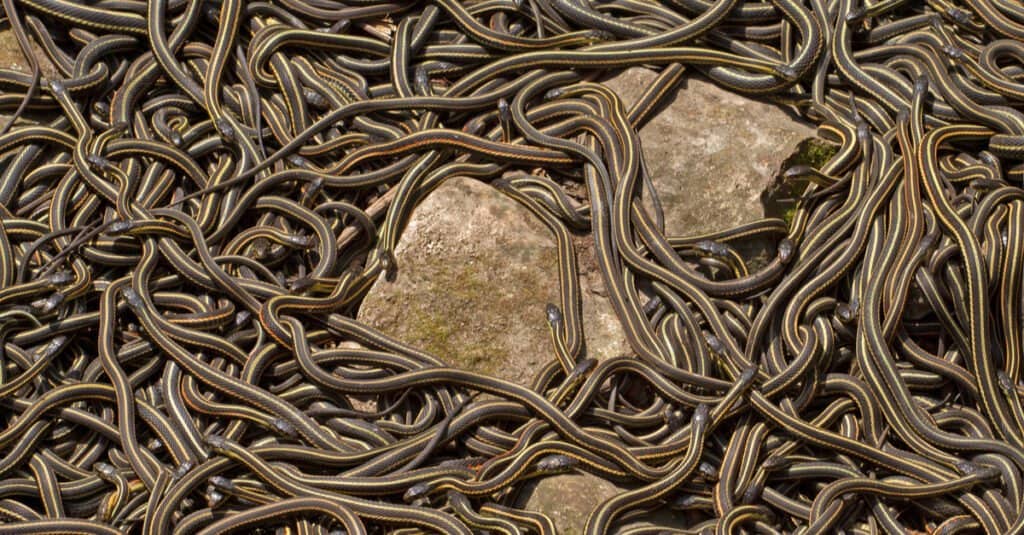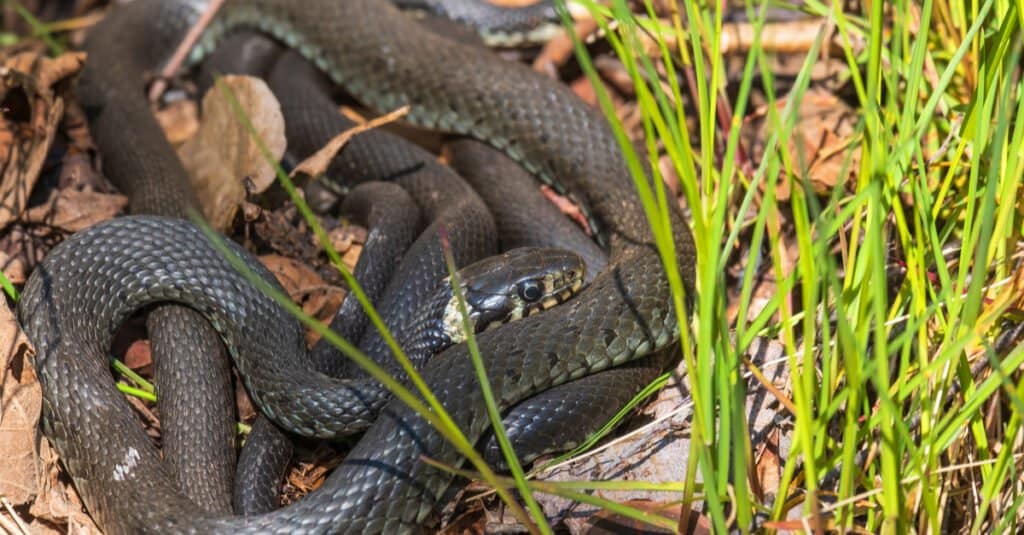Snakes need a warm environment to maintain a normal body temperature. So, snakes living in temperate climates must find shelter from the cold for the winter season. While snakes are known as solitary animals, many of them live in a group over the winter. This group behavior is just one of the many interesting things about these reptiles.
So, what’s a group of snakes called? How many snakes or serpents gather in a group at one time? Where do snakes like to hide out? Learn the answer to all of these questions along with a few more surprising facts about snakes.
What’s a Group of Snakes Called?
A group is called a snake den or pit. When someone refers to a snake den, the word den is used as a collective noun. The collective noun highlights the fact that there’s more than one snake in the group. Along with den and pit, a person may use another collective noun like a snake knot or even a snake bed.
So, what do you imagine when you picture a snake den? It helps to have an idea of the number of snakes involved.
How Many Serpents Are in a Snake Den?
The answer varies depending on what type of snake you’re talking about. A snake den may contain dozens to hundreds of serpents.
The garter snake spends the winter in a group with other garter snakes. A garter snake den can contain hundreds of these snakes at one time. Alternatively, a rattlesnake den may have a few more than 20 snakes in it.
When Do Snakes Go Into a Den?

©Jukka Palm/Shutterstock.com
Snakes living in a temperate climate retire into a den to get away from the cold temperatures in the wintertime. These reptiles are cold-blooded animals. So, their body temperature is dictated by the environment. When the temperature outdoors goes down and there’s less sunlight, a snake isn’t able to maintain a normal body temperature. It can freeze. Alternatively, snakes living in tropical climates don’t have to retire into a den because the temperatures stay warm enough for them to function.
What Are the Benefits of Being in a Snake Den?
All of the individual serpents in a snake den benefit from the warmth generated by the group. The snakes are lying side by side or even on top of one another depending on the size of the space and the number of serpents there.
Living in a den is a great way to retain moisture as well. In arid regions, this is critical to snake survival. Another reason to live in a group is to increase the odds of getting away alive when a predator attacks.
Do the Occupants of a Snake Den Hibernate?
No. Unlike bears and other mammals, these reptiles don’t go into hibernation. Snakes go into something called brumation.
In the late summer and fall seasons, a snake starts eating more to increase its fat stores so it can nourish itself over the winter. But, before winter begins, the snake does a reversal and starts eating less. This is because it knows its digestive process is going to slow down. A snake that goes into brumation with undigested food sitting in its belly is going to die because the food will rot inside it.
When it’s in brumation, a snake’s metabolism is very slow. Though it doesn’t eat, a snake does need to drink water during that time. This is why many serpents overwinter near a stream or creek so they can get access to water. A snake needs to conserve its energy during this cold time of year so it will be ready to reproduce in the spring when it comes out of hiding.
The big difference between brumation and hibernation is snakes in brumation don’t go to sleep. They sometimes rest and move around a little bit within the space but aren’t as active as they are during the warm weather months. So, if you happened upon a snake pit or den would you find all of its occupants snoozing? No.
Do Some Snakes Stay in a Den Alone?
Yes. The word den is not always a collective noun. Sometimes it’s just a singular noun describing a place. Some types of snakes move into a den and stay there alone. Two examples are the Tiger rattlesnake and the Black-tailed rattlesnake. Both of these snakes are solitary and spend their winter months of brumation alone.
Does a Snake Den Ever Contain Different Types of Snakes?
Yes. Biologists have discovered that some types of snakes stay in a group with other types of serpents. The black rat snake has been found in a den with racer snakes, bull snakes, and timber rattlesnakes. They all have the same goal which is to keep warm.
Where is the Typical Snake Den Located?

©TTphoto/Shutterstock.com
Snakes overwinter in many different types of places. Serpents can slither through a crevice in a cliff that leads to a space located four or more feet below ground. This is sometimes called a snake pit because of its location beneath the ground. A snake pit is essentially a hole where snakes gather together to stay warm.
Some snake dens are located in small caves on rocky hillsides. Some snake dens are burrows or tunnels created and abandoned by other types of animals. Most snake dens have a narrow opening that only snakes can fit through. This type of opening protects from predators and larger animals while the snakes are in this weakened and inactive state.
Do Snake Dens Include Both Venomous and Non-Venomous Snakes?
Yes. If venomous and non-venomous snakes share the same habitat they could end up in the same shelter for the winter. For instance, a non-venomous snake such as the Western racer may share a den with a venomous rattlesnake.
Do Snakes Overwinter with Other Types of Animals?
Yes. It seems kind of strange that a snake would brumate alongside another type of animal, but it happens.
Snakes brumate alongside other types of brumating reptiles. As an example, the Western Diamondback rattlesnake has been found in brumation with desert tortoises and even Gila monsters. It makes sense because all of those animals share the same habitat. Plus, anybody inside the space adds warmth to it even if it’s another type of reptile. But would a small mammal like a squirrel or mouse try to share a snake den with serpents just to keep warm? That’s a big no.
Is a Snake Den the Same as a Snake Nest?
No. The phrase snake nest is sometimes used to describe a large group of snakes in one area. A person may report finding a snake nest in their backyard. This probably means the person found a group of snakes together. If this happens during the warm months of the year, then the snakes aren’t in brumation. So, it’s not a snake den.m A snake nest is more appropriately used to describe the place where a female snake lays her eggs. Though most female snakes don’t stay with their eggs, some do remain to guard the nest.
A female king cobra makes a nest of leaves, twigs, and brush. Then, she lays on top of her eggs to guard them against predators until they hatch. This is an example of a true snake nest.
What to Do If You Find a Snake Den?
A snake pit or den is sometimes several feet below ground level. So, it’s not likely that you would encounter one. A snake that comes out of hiding in freezing temperatures is likely going to die before finding other shelters. So, most snakes make sure they settle in a place where they won’t be discovered or disturbed. But, if you ever do encounter a snake pit or den, there are a couple of things to remember.
The main thing is not to disturb the snakes. They are weakened and vulnerable because they are in brumation. However, a snake in brumation can still bite. Just think, the snakes are probably very upset and scared at being disturbed during this inactive period. This may cause them to be aggressive toward the disturbance.
Also, disturbing snakes in the brumation stage may cause some of them to leave their shelter. This is very dangerous for a snake. They are likely to die of exposure before they find their way back to the original shelter or locate a new one.
If you see a snake basking on a rock or wall on a particularly warm month in the wintertime, keep in mind the reptile is still in brumation. A snake can come out of its shelter to warm itself on a day when the temperature goes up a bit. Don’t try to move it anywhere else or find its shelter to return it to the group. The snake has instincts that tell it where to go when the temperature begins to drop again.
The photo featured at the top of this post is © iStock.com/gavwak2012
Discover the "Monster" Snake 5X Bigger than an Anaconda
Every day A-Z Animals sends out some of the most incredible facts in the world from our free newsletter. Want to discover the 10 most beautiful snakes in the world, a "snake island" where you're never more than 3 feet from danger, or a "monster" snake 5X larger than an anaconda? Then sign up right now and you'll start receiving our daily newsletter absolutely free.
Thank you for reading! Have some feedback for us? Contact the AZ Animals editorial team.






